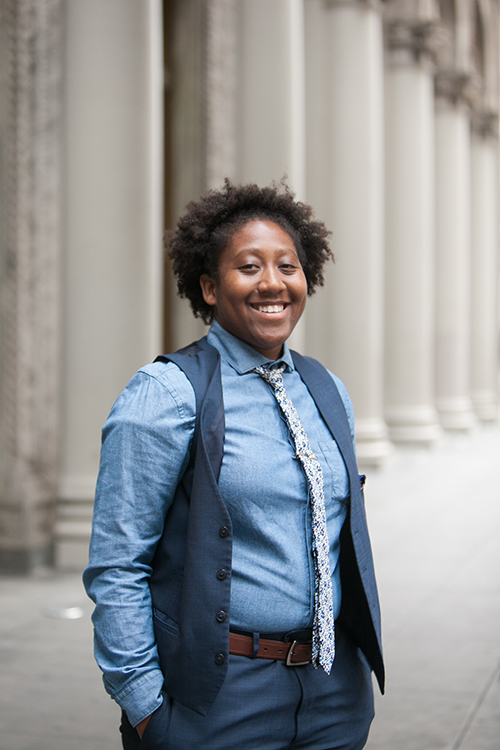This is an interview with Tamika Butler, executive director of the Los Angeles Bicycle Coalition and featured speaker at the 2017 National Walking Summit.
It seems there has historically been some tension between those working to advocate for pedestrians and those working to advocate for bicyclists. Have you encountered this in your own work and what do you think we can do about it? Why do you think it’s important bicycle advocates also promote walkability and vice versa?
I came to this advocacy world with very little knowledge about what had been happening in it. Since I’ve been at the bike coalition, I think we’ve tried very hard to talk about walking and biking, even as even internally there’s been some pushback. I’ve really said we have to be more open, we have to bring people in, not exclude people, because we are in this together, and I think it’s important to view things that way. There are definitely times when we have to function as distinct groups (as in when certain infrastructure proposals affect people who walk and bicycle disparately), but I do think we’re stronger together and I’ve been lucky enough to enter the movement (Butler started working at the L.A. Bicycle Coalition in December 2014) at a time when I think people are getting that and getting the intersections.
Few places are more synonymous with the car than L.A. Less well-known are some of the really important strides being made there in active and public transportation. Can you talk a little about what it’s like working in active transportation advocacy in L.A. in particular? Are there any accomplishments or advances made in recent years about which you’re particularly proud?
L.A. is a car-centric city and that’s what a lot of people see us as. When you Google pictures of L.A. you see cars on the freeway. But there’s another part of L.A.’s history and present that’s all about walking and biking. It kind of feels like we’re in this special moment where all the forces that we need to are aligning. And as advocates we really have to push because there’s been a lot of plans and now we need to work toward implementation.
Butler points to recent achievements including L.A.’s designation as a Vision Zero city; the hiring of transportation czar Seleta Reynolds, who arrived in L.A. from San Francisco, has a strong record of promoting safe walking and bicycling, and is tasked with implementing a plan aimed at doubling the number of bicyclists and dramatically expanding transportation choice in the city; active transportation allies serving on the L.A. City Council; and the passage of Measure M, a transportation sales tax approved by voters in 2016 that will for the first time set aside dedicated funding for active transportation. Butler singles out in particular among the projects that stand to benefit from the ballot measure the L.A. River greenway project, a yet-to-be-completed 51-mile multi-use path stretching between L.A. and Long Beach.
Butler likes to tell the story of a longtime bicycle coalition member who several years ago stopped a woman on the street because she was riding a bike, seemed to be approximately the same size as his ex-girlfriend, and, given that she was a bicyclist, thought she might be interested in the bicycle he’d bought for his ex before their breakup. She was, and the two strangers ignored any apprehensions that might normally occur to two people finding themselves in this situation and headed to his house to check out the bike. “There were so few people you would see out biking that when you saw another person out biking you were like, ‘You’re ok.’ Butler explained. Today, the sense of instant friendship with anyone else on a bike has eroded a bit thanks to the growth in L.A.’s cycling ranks. “It’s been a really big cultural shift here and we’re really excited about it.”
You have a law degree and a background in working to advance social justice. How did you find your way to active transportation advocacy?
I’ve always seen myself as a social justice advocate. I didn’t love being a lawyer, and I actually left law to work at a public health organization, and after that I worked at a foundation that helps boys and men of color. Biking was something I got into after I moved into L.A. in 2012 or 2011 (from the Bay Area). A doctor told me I had gained a lot of weight, probably from spending so much more time than I was used to in my car, and I needed to get active. I had a friend who biked and she convinced me to buy one of my own and shortly after that, I started riding with her. Up until this time, I hated the city of L.A., largely because of how much time I was spending stuck in my car, but the second I got on a bike, I could actually slow down and see how amazing many of the communities are here…I could be in the mountains, I could be at the beach, and I could do all that in one day, powered by myself. And as a result, I really started of fall in love with the city. As it turns out, the same friend who convinced me to buy a bike was the same friend who introduced me to my girlfriend who is now my wife. That friend was also a member of the bike coalition, and when they announced they were looking for an executive director, she sent me the announcement and encouraged me to apply for the job.
How does your social equity lens continue to influence your current work?
When I applied for the job, I said to the board, ‘I’m a queer, gender nonconforming woman of color, and that’s the lens through which I see my work and if I take this job, this is going to be a social justice organization.’ I think for me, as a person who lives at the intersections, it’s impossible not to see the intersections in the work. I think the intersections were always here and I love that they’re here and I’ve just been really able to highlight them and talk about them more. There have been people in the transportation world doing this for a really, really long time and I’m just following in their footsteps.
In terms of how this translates to coalition policy and initiatives, Butler describes making a concerted effort to “push boundaries” and to place the needs of low-income people and people of color at the forefront of the coalition’s work.
The bike is second to me. The bike is a tool for social justice.
What is one thing you’re looking forward to doing, seeing, or exploring in St. Paul?
I’m originally from Omaha, Nebraska so I’m a Midwest kid. I’ve been (to the Twin Cities) a few times with family and know a lot about the area, but never really been on my own as a full-fledged adult, so that’s exciting. We just had a big park equity summit here put on by an organization called the L.A. Neighborhood Land Trust that was awesome, awesome, awesome. We were there as a transportation organization, but to see how folks talked about parks and talked about active transportation and walking and biking and the overlap was really pretty cool. And one of the other things that made it cool was the keynote by Jayne Miller, the superintendent of the Minneapolis Park and Recreation Board. She gave this awesome talk about how so many people, way more than in L.A., can just walk out of their front door and be within walking distance of a park, so I’m actually really excited to just take a walk in a park when I’m there.














